You can Download Samacheer Kalvi 6th Social Science Book Solutions Guide Pdf, Tamilnadu State Board help you to revise the complete Syllabus and score more marks in your examinations.
Tamilnadu Samacheer Kalvi 6th Social Science History Solutions Term 1 Chapter 3 Indus Civilisation
Samacheer Kalvi 6th Social Science Indus Civilisation Textual Evaluation
I. Choose the correct answers:
Question 1.
What metals were know to the people of Indus Civilisation?
(a) Copper, bronze, silver, gold, but not iron
(b) Copper, silver, iron, but not bronze
(c) Copper, gold, iron, but not silver
(d) Copper, silver, iron, but not gold
Answer:
(a) Copper, bronze, silver, gold; but not iron
Question 2.
Indus Civilization belonged to ………………..
(a) Old Stone age
(b) Medieval stone age
(c) New Stone age
(d) Metal age
Answer:
(d) Metal age
Question 3.
River valleys are said to be the cradle of civilisation because.
(a) Soil is very fertile
(b) They experience good climate.
(c) They are useful for transportation
(d) Many civilisations flourished on river valleys.
Answer:
(d) Many civilisations flourished on river valleys.
II. Match the statement whit the reason. tick the appropriate answers:
Question 1.
Statement : Harappait civilization is said to be ait urban civilizations,
Reason : It has well planned cities with advanced drainage systems.
(a) Statement and reason are correct.
(b) Statement is wrong.
(c) Statement is true, but the reason is wrong.
(d) Both statement and reason are wrong.
Answer:
(a) Statement and reason are correct.
![]()
Question 2.
Statement : Harappan civilisation belongs to Bronze age.
Reason : Harappans did not know the use of iron.
(a) Statement and reason are correct.
(b) Statement is wrong.
(c) Statement is correct, but the reason is wrong.
(d) Both statement and reason are wrong.
Answer:
(a) Statement and reason are correct.
Question 3.
Statement : The engineerring skill of Harpones was remarkable
Reason : Building docks after u careful study Of tides, waves and currents.
(a) Statement and reason are correct.
(b) Statement is wrong.
(c) Statement is correct, but the reason is wrong.
(d) Both statement and reason are wrong.
Answer:
(a) Statement and reason are correct.
Question 4.
Which of the following statements about Mohenjo – Daro is correct?
(a) Gold ornaments were unknown.
(b) Houses were made of burnt bricks.
(c) Implements were made of iron.
(d) Great Bath was made water tight with the layers of natural bitumen
Answer:
(b) and (d)
Question 5.
Cosidering the following statement:
1. Uniformity in layout of town, streets, and brick siz
2. An elaborate and well laid out drainage system
3. Granaries constituted an important part of Harappan Cities
Which of the above statement are correct?
(a) 1&2
(b) 1&3
(c) 2&3
(d) all the three
Answer:
(d) all the three
![]()
Question 6.
The odd one
Answer:
Oxen, sheep, buffaloes, pigs, horses
Find out the wrong pair
(b) Citadel – Granaries
(a) ASI John – Marshall
(c) Lothal – dockyard
(d) Harappan civilisation – River Cauvery
Answer:
(d) Harappan civilisation – River Cauvery
III. Fill in the blanks:
- ________ is the oldest civilisation.
- Archaeological Survey of india was founded by ________
- ________ were used to store grains.
- Group of people ________ form
Answer:
- Mesopotamian civilization
- Alexander cunningham
- Granaries
- Community
IV. State True or False:
- Mehergarh is a Neolithic site.
- Archaeological Survey of India is responsible for the preservation of cultural monuments
- in the country.
- Granaries were used to store grains
- The earliest form of writings was developed by the Chinese.
Answer:
- True
- True
- True
- False
V. Match the following :
- Mohenjo Daro – (i) raised platform
- Bronze – (ii) red quartz stone
- Citade – (iii) alloy
- Carnelian – (iv) mound of dead
Answer:
- iv
- iii
- i
- ii
VI. Answer in one or two sentences:
Question 1.
What are the uses of metal?
Answer:
- Iron or steel is used for the construction of buildings, houses, automobile parts, etc.
- Copper is used for electrical purposes and also for making ornaments.
Question 2.
Make a list of baked and raw food that we.
Answer:
Raw food: Fruits and vegetables like apples, carrots, cucumber, etc.
Baked food: Bread, Bun, Cake, Cookie, Pudding, etc.
![]()
Question 3.
Do we have the practice of worshipping animals and trees?
Answer:
- Yes, people worship the Peepal tree also known as Bodhi tree, Banyan tree, Bel tree! Ashoka tree, Mango tree etc.
- Cow, Monkey, Snake, Elephant are also considered very sacred.
Question 4.
River valleys are cradles of civilization. why?
Answer:
- River valley had fertile soil. Agriculture grew well in these regions.
- Freshwater was available for drinking, Watering livestock, and irrigation.
- Easy movement of people and goods as possible.
Question 5.
Just because a toy moves it doesn’t mean it’s modern. What did they use instead of batteries?
Answer:
They used wheels to move the toys instead of batteries.
Question 6.
The dog was the first animal to be tamed. Why?
Answer:
Humans started breeding dogs to help with hunting, herding, standing guard and carrying stuff.
Question 7.
If you were an archaeologist, what will you do?
Answer:
if I were an Archaeologist, I will study the artifacts found in the ground to learn about people where lived in the past.
![]()
Question 8.
Name any two Indus sites located in the Indian border?
Answer:
- Ralibangan (Rajasthan)
- Dholavira (Gujarat).
Question 9.
In Indus civilization, which features you like the most? Why?
Answer:
- Town planning is a unique feature of the Indus civilization.
- Straight and wide road with the good drainage system of the Indus Valley is a significant feature.
Question 10.
What instrument Is used nowadays to weigh things?
Answer:
A weighing scale or spring balance is used nowadays to weigh things.
VII. Answer the following:
Question 1.
What method is used to explore buried buildings nowadays?
Answer:
- Archaeologists study the physical objects such as bricks, stones, or bits of broken pottery to ascertain the location of the city and the time that it belonged to.
- They search the ancient literary sources for references about the place.
- They look at aerial photographs of the excavation sites or cities to understand the topography.
- They use a magnetic scanner to see under the ground.
- The presence and absence of archeological remains can be detected by RADAR and remote sensing methods.
Question 2.
Why did the Indus civilization call Bronze age civilization?
Answer:
Indus civilization is called the Bronze age civilization because it is a historical period characterized by the use of articles made of bronze.
Question 3.
Indus Civilisation is called urban civilization. Give reason
Answer:
Indus Civilisation is called urban civilization because
- There was well-conceived town planning.
- Astonishing masonry and architecture were found.
- Priority was given to hygiene and public health.
- They used Standardised weights and measures
- They had solid agricultural and
Question 4.
Can you point out the special features of their drainage system?
Answer:
- The cities had covered drains.
- They were covered with slabs or bricks.
- There were manholes at regular intervals to clean the drains.
- Every house had its own soak pit, which collected all the sediments and allowed only the water to flow into the street drain.
Question 5.
What do you about great the great bath?
Answer:
- The great bath was a large, rectangular tank in a courtyard. It may be the earliest example of a waterproof structure.
- The bath was lined with bricks, coated with plaster, and made watertight using layers of natural bitumen.
- There were steps on the north and south leading into the tank.
- There were rooms on three sides.
- Water was drawn from the well, located in the courtyard, and drained out after use.
![]()
Question 6.
How do you know that Indus people traded with other countries?
Answer:
- There is evidence for extensive maritime trade with Mesopotamia, Indus Seals have been found as far as Mesopotamia.
- King Naram- Sin of Akkadian Empire (Sumerian) has written about buying jewellery from the land of Melukha (a region in the Indus Valley).
- Cylindrical seals Similar to those found in Persian Gulf and Mesopotamia have also been found in the Indus area.
- A naval dockyard has been discovered in Lothal. It shows the maritime activities of the Indus people.
VIII. HOTS:
Observe the following features of Indus Civilisation and compare that with the present day.
a. Lamppost
b. Burnt bricks
c. Underground drainage system
d. Weights and measurement
e. Dockyard
Answer:
(a) Lamppost
- In Indus Valley archaeologists have discovered lamp posts at intervals. This suggests the existence of street lights.
- Today street lighting commonly uses high-intensity discharge lamps often HPS—high-pressure sodium lamps.
(b) Burnt bricks
(i) In Harappan Civilization, the houses were built using baked bricks and ’mortar. Sun-dried bricks were also used, Most of the bricks were of uniform size. They used the burnt bricks which were strong, hard, durable, resistant to fire, and would not dissolve in water.
(ii) Even at present, brick is the most basic and favoured material for common construction throughout the world. Nowadays bricks are available in different sizes and shapes. Kiln burnt bricks are used.
(c) Underground drainage system
(i) In Indus Civilization, they had covered drains. The drains were covered with slabs or bricks. Each drain had a gentle slope. Manholes were provided at regular intervals to clear the drain.
(ii) At present our cities and town are so populated and congested that conducting any infrastructural improvement over ground or underground is becoming difficult.
(d) Weights and measurement,
(i) Indus people used standardized weights and measures. They used sticks with marks to measure length.
(ii) In the modem world, we use electronic weighing machines to have accuracy in weighing. Floor scales and Platform scales are used in industries and small-scale industries respectively.
(e) Dockyard
(i) A naval dockyard has been discovered in Lothal in Gujarath. It shows the maritime activities of the Indus people.
(ii) In modem days, there are many well-developed ports in India. To quote a few, Chennai port, Kandla port, Tuticorin port, Cochin port, Paradip port, etc.
Question 2.
Agriculture was one of their occupations. How can you prove this? (with the findings)
Answer:
- Agriculture was one of their main occupations. They cultivated wheat, barley, millets, sesame, and pulses.
- There were granaries to store food grains. A granary has been discovered in a village in the state of Haryana.
- Ploughs have been unearthed. All these things show that agriculture was one of their occupations.
![]()
Question 3.
Many potteries and Their pieces have been discovered from Indus sites. What do you know from that?
Answer:
- Pottery was practised using the potter’s wheel. It was well fired.
- Potteries were red colour with beautiful designs in black.
- The broken pieces of pottery have animal figures and geometric designs on it.
- All these reveal the fact that the Indus people had the very good artistic skill, colour concept and rich imagination.
Question 4.
A naval dockyard has been discovered in Lothal. What does it convey?
Answer:
A naval dockyard shows the maritime activities of the Indus people. It stands as proof of their maritime trade.
Question 5.
Can you guess what happened to the Harappans?
- By 1800 BCE, the Harappan culture had started declining.
- It is assumed that the civilization met with
(a) repeated floods
(b) ecological changes
(c) invasions
(d) natural calamity
(e) climatic changes
(f) deforestation
(g) an epidemic might have disturbed the civilization.
IX. Student Activity :
Question 1.
Prepare a scrapbook,
(Containing more information about objects collected from Mohenjo-Daro and Harappa.)
Hints :
(i) Mohenjo-Daro Findings – Notable Artefacts- seated and standing figures, copper and stone tools, balance scale and weighs, gold and Jasper jewellery, children Toys. The Dancing girl statue at National Museum, Delhi.
(ii) Harappan findings – seal with a yogic picture representing Pashupathi toys, household implements, pottery displayed in Harappan gallery, National Museum, Delhi.
Question 2.
You arc a young archaeologist working at a site that was once an Indus city. What will you collect?
Hints:
- As a young archaeologist with Indus site will examine the artifacts found, followed by documenting and preserving them,
- Compile the information collected with photos. Then analyses the findings from different angles with the help of
Question 3.
Crossword puzzle.
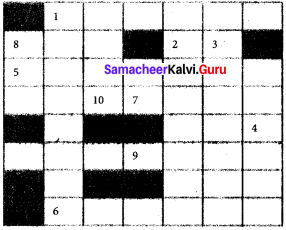
Top to Bottom
- Director General of ASI
- _______ is older than Mohenjo-Daro
- This is _______ age civilisation
- Each house had a _______
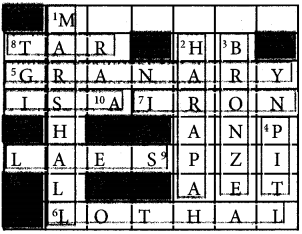
Left to Right
- Place used to store grains
- A dockyard has been found
- _______ is unknown to Indus people
- It is used to make watertight.
Right to left
- From this, we can get a lot of information
- This is responsible for research
![]()
X. Rapid Fire Quiz (Do it in groups)
Question 1.
Which crop did Indus people use to make clothes?
Answer:
Cotton.
Question 2.
Which was the first Indus city discovered?
Answer:
Harappa.
Question 3.
Where was Indus Civilisation?
Answer:
Banks of River Indus.
Question 4.
Which animal was used to pull carts?
Answer:
OX, Buffalo.
![]()
Question 5.
Which metal was unknown to the Indus people?
Answer:
Iron.
Question 6.
What was used to make pots?
Answer:
Potter’s wheel.
Question 7.
Which is considered the largest civilization among four ancient civilizations of the
world?
Answer:
Indus Valley Civilization.
XI. Map work
- Mark any four Indus sites located within the Indian border.
- On the river map of India, colour the places where Indus civilization spread.
- Mark the following places in the given India map:
(a) Mohenjo-Daro
(b) Chanhudaro
(c) Harappa
(d) Mehergarh
(e) Lothal
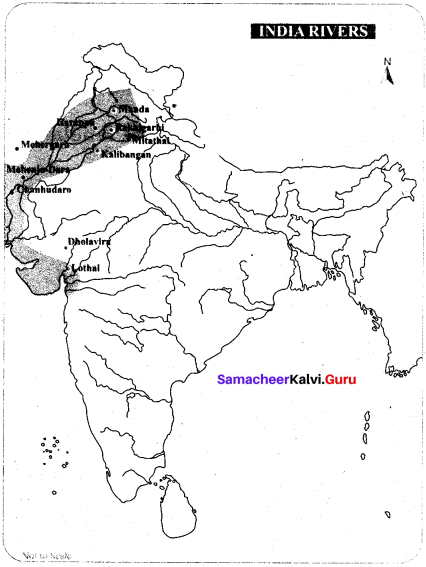
XII. Answer Grid
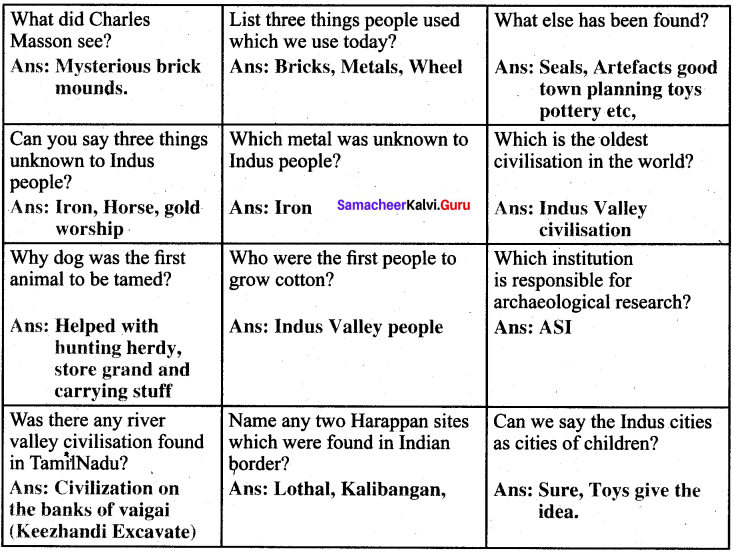
Samacheer Kalvi 6th Social Science Indus Civilisation In-Text Question
Observe the picture and fill the tabular column.
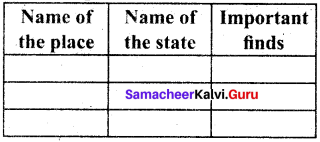
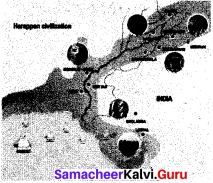
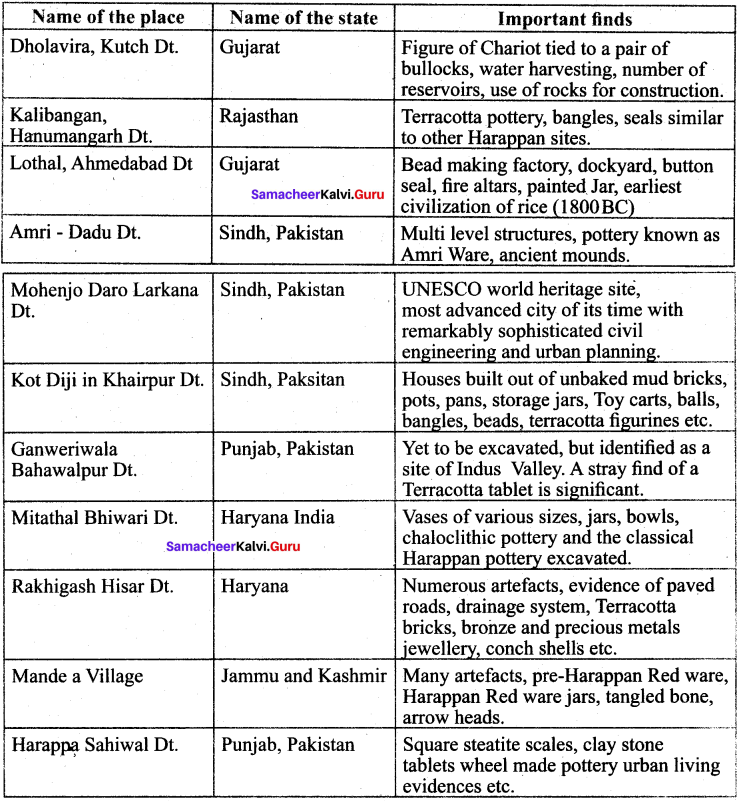
Samacheer Kalvi 6th Social Science Indus Civilisation Additional Question
I. Choose the correct answer:
Question 1.
Indus valley civilization is great, because
(a) It had an advanced sanitation and drainage system.
(b) Repeated floods affected this area.
(c) Indus people maintained a big army.
(d) They did not use iron
Answer:
(a) It had an advanced sanitation and drainage system.
![]()
Question 2.
The assembly hall was located at ……………
(a) Harappa
(b) Mohenjo – Daro
(c) Lothal
(d) Kalibangan
Answer:
(b) Mohenjo – Daro
II. Match the statement with the Reason. Tick the appropriate answer:
Question 1.
Statement: Harappans knew the art of writing.
Reason: Harappans wrote on seals and pottery.
(a) Statement and Reason are correct
(b) Statement is correct, Reason is wrong.
(c) Statement is wrong, Reason is correct.
(d) Both statement and Resonance wrong
Answer:
(a) Statement and Reason are correct
Question 2.
Statement: The Harappan city had two planned areas.
Reason: Each house was one or two stories.
(a) Statement and Reason are correct
(b) Statement and Reason are wrong.
(c) Statement correct Reason wrong.
(d) Statement wrong Reason correct.
Answer:
(a) Statement and Reason are correct
![]()
Question 3.
Which one of the following is correct?
- Indus valley civilization is an urban civilization.
- In urban civilisation people shift from rural areas to urban areas.
- They live a settled life.
(a) (i) and (ii) are correct
(b) (ii) and (iii) are correct
(c) (i) and (iii) are correct
(d) (i), (ii), and (iii) are correct
Answer:
(d) (i), (ii), and (iii) are correct
Question 4.
The following statements about Mohenjodaro are correct.
(a) People led a nomadic life.
(b) Hunting was the main occupation
(c) Well planned streets were there
(d) They did not have a script
Answer:
(c) Well planned streets were there
Question 5.
Consider the following statements.
- Harappans used carts with spokeless solid wheels.
- In Harappan society, there were merchants, traders, and artisans.
- Cotton fabrics were in common use.
Which of the above statements are correct.
(a) i and ii
(b) ii and iii
(c) i and iii
(d) all the three
Answer:
(d) all the three
![]()
Question 6.
Circle the odd one:
(a) Bangles
(b) Armlets
(c) Necklaces
(d) Seals
Answer:
(d) Seals
Question 7.
Find out the wrong pair.
(a) Lothal – Dockyard
(b) Janpath – New Delhi
(c) Mohenjodaro – Mound of dead
(d) Camelian – Pottery
Answer:
(d) Carnelian – Pottery
III. Fill in the blanks:
- The archaeologists began to excavate the cities of Harappa and Mohenjodaro in the ________
- The word civilization comes from the ancient Latin word ________
- A huge public building found at Mohenjodaro was the ________
- Lothal is situated on the banks of a tributary of ________
- In Indus civilisation settlements were built on ________
- The earliest form of writing was developed by the ________
Answer:
- 1920s
- Civis
- assembly hall
- Sabarmati
- elevated
- Sumerians
IV. State True or False:
- The Archaeological Survey of India (ASI) was started in 1924.
- Indus Civilisation had covered 6 big cities.
- Mesopotamia was modem day Iraq, Kuwait, and parts of Syria.
- Bitumen is nothing but water-proof Tar
Answer:
- False
- True
- True
- True
![]()
V. Match the following:
- Charles Masson – (i) Neolithic
- Mehergarh – (ii) First metal
- Radar – (iii) Explorer
- Copper – (iv) Remote sensing
Answer:
- Charles Masson – (iii) Explorer
- Mehergarh – (i) Neolithic
- Radar – (iv) Remote sensing
- Copper – (ii) First metal
VI. Answer in or two sentences :
Question 1.
Mention the importance of Rakhigarh village.
Answer:
- Rakhigarh is a village in Haryana.
- A granary with walls made of mud, bricks, which are still in a good condition, has been discovered here.
Question 2.
Why did they use burnt bricks for construction?
Answer:
Burnt bricks are strong, hard, durable, resistant to fire, and will not dissolve in water or rain.
Question 3.
Who governed the Indus valley people?
Answer:
Historians believe that there existed a central authority that controlled the planning of towns and overseas trade, maintenance of drainage, and peace in the city.
Question 4.
Write a few sentences about pot making.
Answer:
- The wheel was used in pot making.
- Pots were burnt.
- They were painted.
- They drew figures of animals on the pots.
Question 5.
What is meant by Ziggurat?
Answer:
- Ziggurat means temple.
- In Mesopotamia, King Ur Nammu built Ziggurat in honour of the Moon God Sin.
VII. Answer the following:
Question 1.
How do archaeologists explore a lost city?
Answer:
- Archaeologists study the physical objects such as bricks, stones or bits of broken pottery to ascertain the time that they belong to.
- They search the ancient literary sources for references about the place.
- They look at the aerial photographs to understand the topography.
- To see under the ground, they may use a magnetic scanner.
Question 2.
What do you understand by the excavation of granary in the Indus Civilization?
Answer:
- The granary was a massive building with a solid brick foundation.
- They were used to store food grains.
- The remains of wheat, barley, millets, sesame, and pulses have been found here.
- It shows that they had surplus grains.
- To safeguard the grains stored with the granary, the granary was built on a raised platform.
- They should have had a good standard of agriculture.
Question 3.
Was there any leader in Mohenjodaro? Explain.
Answer:
- A sculpture of a seated male has been un earthed in a building, with a headband on the forehead and a smaller ornament on the right upper arm.
- His hair is carefully combed, and his beard finely trimmed.
- Two holes beneath the ears suggest that the head ornament might have been attached to the ear.
- The left shoulder is covered with a shawl-like garment decorated with designs of flowers and rings.
- This shawl pattern is used by people even today in those areas.
![]()
VIII. HOTS:
Question 1.
Why should we learn about the Indus Valley Civilization?
Answer:
- The Indus Valley civilization was a Bronze Age civilization in the world.
- It was the largest among the four ancient civilizations of the world.
- At its peak, it might have had a population of over 5 million.
- To date over 1056 cities have been discovered.
- Archaeologists first thought they had discovered cities of children since during excavation they found more and more toys.
- Britishers laid down 93 miles of railway track with 4,000-year-old Indus Valley bricks.
- They had the world’s first planned cities
- Their sanitation systems and drainage systems were much advanced than any other ancient civilizations.
- By learning about this civilization, we realize the richness of our ancient past